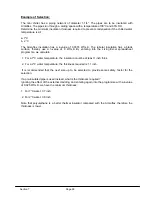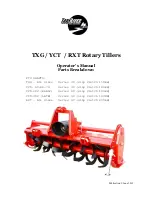
Glycol Solutions
As mentioned earlier, the mini chiller has two water sensors at the BPHE:
a) Water Entering Temperature Sensor
This has an adjustable range of 10 to 15°C. Adjustment is by turning a varistor on the
electronic controller board. Refer to the Technical Manual for more details on this adjustment.
However, if required, this can further be adjusted down to 3°C, i.e. with a leaving water
temperature of approximately -2°C. Such requirements are usually needed for process cooling
whereby sub-zero water temperatures are used for cooling of machines and equipment. It is
recommended to consult trained technicians or service personnel to perform this adjustment.
b) Anti-Freeze Sensor
This sensor will protect the water temperature from becoming too low and freezes up.
Formation of ice in the BPHE will cause it to crack due to expansion. Therefore, the factory
setting for this sensor is 2°C. However, if required, this can be further adjusted to a
minimum of -4°C, i.e. when used in special process cooling applications. Again, consult
trained technicians to do this adjustment.
Because of the danger of the water becoming ice, special precautions must be taken:
1. For sub-zero applications, the water must mix with anti-freeze glycol solution. There
are two commonly used types: ethylene glycol and propylene glycol. In some
instances, brine (sodium chloride) is used.
Whatever type is used, the quantity mixed with the water must be sufficient to reduce the
water freezing point to cater for the operating water temperature in the process cooling. It is
recommended the freezing point is at least 3°C below the operating temperature. For
example, if a temperature of -2°C is required, we need to ensure that the water freezing
temperature is at least -5°C to prevent ice formation. Looking at the property table of
ethylene glycol, the mixture should have about 13% glycol by volume in order to have the
required freezing point. See Appendix 15.
If propelyne glycol is used, the percentage should be about 14.5% by volume.
The minimum operating temperature of ethylene glycol is -23°C and of propylene glycol is
-18°C. The lower water freezing temperature is required, the higher concentration of glycol
must be used. However, the viscosity of the mixture will increase, thus increasing pumping
power requirements and reducing heat transfer efficiency. High concentrations of glycol will
also increase costs and adversely affect the physical properties of the fluid.
2. Make sure that the water pump is ON all the time the chiller is in use. This will ensure no
stagnation of water in the BPHE which reduces the risk of ice formation.
Section 9
Page 113
Summary of Contents for AC 40A
Page 1: ...AM MAC ...
Page 153: ...Appendix 1 ...
Page 154: ...Appendix 2 Appendix 2 ...
Page 157: ...GRAPH OF PRESSURE DROP VS FLOW FOR VARIOUS C V RATINGS Appendix 5 1 ...
Page 158: ......
Page 159: ...Water Capacity Graph Appendix 5 2 ...
Page 160: ...CHART 3 FRICTION LOSS FOR CLOSED PIPING SYSTEMS Appendix 6 1 ...
Page 161: ...CHART 4 FRICTION LOSS FOR OPEN PIPING SYSTEMS Appendix 6 2 ...
Page 162: ...CHART 5 FRICTION LOSS FOR CLOSED AND OPEN PIPING SYSTEMS Appendix 6 3 ...
Page 168: ...Appendix 8 Appendix 8 ...
Page 169: ...Appendix 8 1 ...
Page 170: ...Appendix 8 2 ...
Page 171: ...Appendix 8 3 ...
Page 172: ...Appendix 8 4 ...
Page 173: ...Appendix 8 5 Appendix 8 5 ...
Page 174: ...Appendix 8 6 Appendix 8 6 ...
Page 175: ...Appendix 8 7 Appendix 8 7 ...
Page 176: ...Appendix 9 ...
Page 178: ...Appendix 11 1 Appendix 11 1 ...
Page 179: ...Appendix 11 2 Appendix 11 2 ...
Page 180: ...Appendix 13 ...
Page 181: ...Appendix 13 1 ...
Page 182: ...Appendix 14 Appendix 14 ...
Page 183: ...Appendix 15 1 Appendix 15 1 ...
Page 186: ...Appendix 17 Appendix 17 ...
Page 187: ...Appendix 18 ...
Page 188: ...CE20DW CE25DW Note PRESSURE DROP CORRECTION FACTOR 1 2947 0 0021 EWTºF Appendix 19 ...
Page 189: ... 2003 McQuay International 603 55194922 www mcquayup com ISO 9002 REGISTERED ...
















































